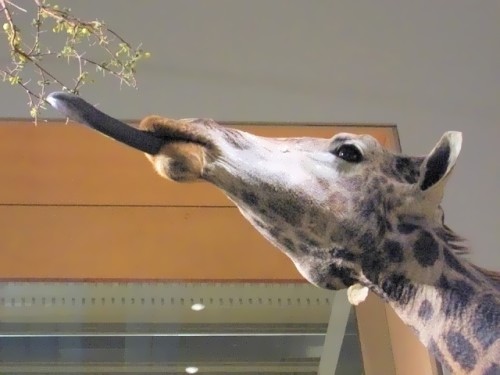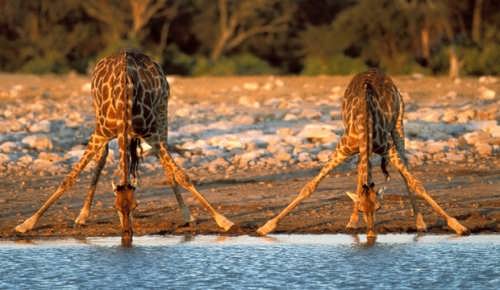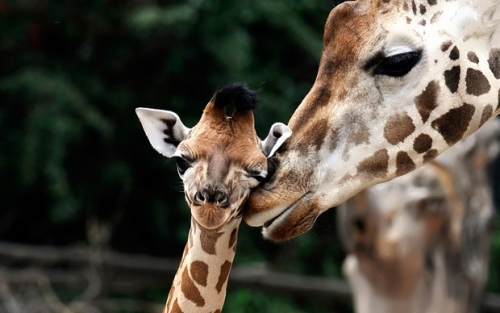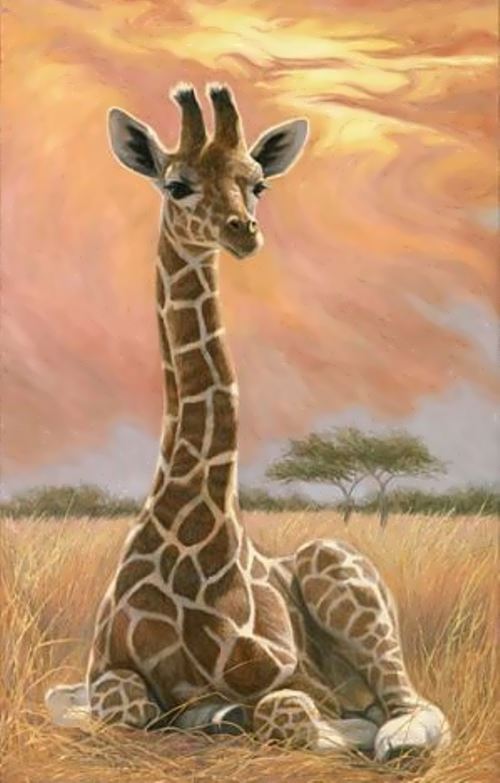Wonderful Giraffes
The giraffe is the tallest of all animals. A male giraffe may grow more than 5.5 meters tall — 1.5 meters taller than the African elephant, the second tallest animal. The giraffe’s legs are 1.8 meters long, and its neck may be even longer. But even though giraffes tower over other animals, most adult males weigh only about 1,200 kilograms. A male African elephant may weigh more than 5 times as much.
The scientific name of a giraffe is camelopardalis, from Latin cameleopard (camel + leopard). People in Ancient Rome gave this name to the animal because it was great, like a camel, and spotted like a leopard. Giraffe and camel can do without water for a long time.
The most striking feature of the giraffe is its long neck. It’s amazing, but giraffes and humans have the same number of neck bones. Jean Baptiste de Lamarck, a famous French zoologist, had an interesting theory about it. He believed that at one time the giraffe’s neck had been much shorter, and that it had grown to its unusual length because of the animal’s habit of reaching for the tender leaves in the upper branches of trees. This theory is not held by scientists in general. However, it is true that the giraffe can pick the leaves from the upper branches of the mimosa and acacia trees which it likes so much.
Giraffes live in Africa south of the Sahara in open woodlands. There they lead a simple life, but they live in constant fear of their enemy, the lion.
They feed on the leaves, twigs, and fruit of trees and bushes. Like cows, they chew a cud, which is food that has entered the stomach but is returned to the mouth for a second chewing. The giraffe uses its long upper lip and its tongue, which is about 53 centimetres long to gather food from tree branches. The animal can clean the ears with its tongue.

It’s not easy to see giraffes standing among trees. Do you know why? It’s because of the special markings on their bodies. A giraffe’s coat has patchlike markings of tawny (light brownish-yellow) to chestnut-brown. The lines that separate the patches are lighter tawny or white. This colour pattern helps to protect giraffes by making them hard to see when they stand among trees. Also, their long legs look a bit like tree trunks. Trees almost hide the animals. The spots on their skin are unique as human fingerprints.
The giraffe’s head is small and narrow, and the eyes, dark and soft, give the animal a gentle and innocent expression.
On its head the giraffe has two short horns covered with skin and hair. Some of them have a third small horn on the forehead. The horns of the female are smaller than those of the male.
Giraffes have good vision and hearing. They seldom use their voice, low and throaty, but can utter a variety of soft sounds. They sometimes snore, groan, hiss and make sounds similar to the sound of the flute.
The giraffe’s gait is very funny. It walks by lifting the two legs on one side of the body and then the other two on the other side. However, it can gallop at more than 56 kilometres an hour.
Despite the enormous length, the giraffe’s neck is really too short to reach the ground. It’s amusing to watch the giraffe in the act of drinking or picking something from the ground. To do this it must spread its legs apart, which it does so clumsily that it makes him look very funny.

A female giraffe carries her young inside her body for about 15 months before giving birth. A new-born baby giraffe is about 1.8 metres tall and weighs 68 kilograms. In an hour the baby will be able to stand on its legs. Newborn giraffe has horns. The cow (female giraffe) nurses its young with milk for nine or ten months, though the baby eats small amounts of green plants from the age of two weeks. A young giraffe grows very quickly. A one-year-old giraffe is already about 2.8 meters tall.
Only one baby giraffe is born to a mother at a time. Sometimes a few young giraffes may be seen staying close to an adult female giraffe, though she is not their mother. Often a female adult giraffe will watch over young ones who are not her own. She’s like a giraffe baby-sitter.
Giraffes rest in the middle of the day, when it is hot. If they lie down, they twist their heads and rest them on their own bodies. They don’t sleep long, only a few minutes at a time. Very often giraffes don’t even lie down: with their eyes half closed, they take a short nap standing.

Wonderful Giraffes
When the animals sleep or have a rest one of them (sometimes more) always stands on guard.
When a giraffe sees danger it gives a warning cry, and all the giraffes start running. Very young animals, however, cannot run as fast as their parents. So sometimes a mother with a young giraffe will not be able to escape from a lion. Then she nudges her young one to a safe place — under her own body, between her front legs. If a lion comes close and tries to attack, the giraffe will kick out with her hard front hooves. These blows can be very powerful. Then the giraffe can gallop off safely with her young one.
Something else helps to keep the giraffes safe — a little bird called the tick bird.
The tick bird runs all over the animal’s back and stomach, but the giraffe doesn’t mind. The tick bird is looking for ticks. When the little bird sees danger it runs up the giraffe’s neck and uses its beak to tap a warning to the giraffe.
Giraffes are very stinky. So they protect themselves from parasites. A number of African tribes called giraffes “smelly bulls”.
Male giraffes fight using the strongest part of the body – neck.
Giraffes are the only animals that cannot yawn.
Giraffes have a relative – an animal called the okapi. It is also called forest giraffe.







